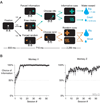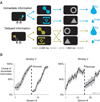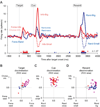Midbrain dopamine neurons signal preference for advance information about upcoming rewards
- PMID: 19607797
- PMCID: PMC2723053
- DOI: 10.1016/j.neuron.2009.06.009
Midbrain dopamine neurons signal preference for advance information about upcoming rewards
Abstract
The desire to know what the future holds is a powerful motivator in everyday life, but it is unknown how this desire is created by neurons in the brain. Here we show that when macaque monkeys are offered a water reward of variable magnitude, they seek advance information about its size. Furthermore, the same midbrain dopamine neurons that signal the expected amount of water also signal the expectation of information, in a manner that is correlated with the strength of the animal's preference. Our data show that single dopamine neurons process both primitive and cognitive rewards, and suggest that current theories of reward-seeking must be revised to include information-seeking.
Figures





Similar articles
-
Midbrain dopamine neurons encode a quantitative reward prediction error signal.Neuron. 2005 Jul 7;47(1):129-41. doi: 10.1016/j.neuron.2005.05.020. Neuron. 2005. PMID: 15996553 Free PMC article.
-
Correlated coding of motivation and outcome of decision by dopamine neurons.J Neurosci. 2003 Oct 29;23(30):9913-23. doi: 10.1523/JNEUROSCI.23-30-09913.2003. J Neurosci. 2003. PMID: 14586021 Free PMC article.
-
Dissociable cost and benefit encoding of future rewards by mesolimbic dopamine.Nat Neurosci. 2010 Jan;13(1):25-7. doi: 10.1038/nn.2460. Epub 2009 Nov 10. Nat Neurosci. 2010. PMID: 19904261 Free PMC article.
-
Involvement of basal ganglia and orbitofrontal cortex in goal-directed behavior.Prog Brain Res. 2000;126:193-215. doi: 10.1016/S0079-6123(00)26015-9. Prog Brain Res. 2000. PMID: 11105648 Review.
-
Expectations and outcomes: decision-making in the primate brain.J Comp Physiol A Neuroethol Sens Neural Behav Physiol. 2005 Mar;191(3):201-11. doi: 10.1007/s00359-004-0565-9. Epub 2004 Oct 12. J Comp Physiol A Neuroethol Sens Neural Behav Physiol. 2005. PMID: 15759141 Review.
Cited by
-
Natural environments, ancestral diets, and microbial ecology: is there a modern "paleo-deficit disorder"? Part I.J Physiol Anthropol. 2015 Jan 31;34(1):1. doi: 10.1186/s40101-015-0041-y. J Physiol Anthropol. 2015. PMID: 25636731 Free PMC article. Review.
-
Neuronal Reward and Decision Signals: From Theories to Data.Physiol Rev. 2015 Jul;95(3):853-951. doi: 10.1152/physrev.00023.2014. Physiol Rev. 2015. PMID: 26109341 Free PMC article. Review.
-
Attention as a decision in information space.Trends Cogn Sci. 2010 Jun;14(6):240-8. doi: 10.1016/j.tics.2010.03.001. Epub 2010 Apr 17. Trends Cogn Sci. 2010. PMID: 20399701 Free PMC article. Review.
-
Dopamine neuron ensembles signal the content of sensory prediction errors.Elife. 2019 Nov 1;8:e49315. doi: 10.7554/eLife.49315. Elife. 2019. PMID: 31674910 Free PMC article.
-
Intervention changes acoustic peak frequency and mesolimbic neurochemistry in the Pink1-/- rat model of Parkinson disease.PLoS One. 2019 Aug 2;14(8):e0220734. doi: 10.1371/journal.pone.0220734. eCollection 2019. PLoS One. 2019. PMID: 31374106 Free PMC article.
References
-
- Ahlbrecht M, Weber M. The resolution of uncertainty: an experimental study. Journal of institutional and theoretical economics. 1996;152:593–607.
-
- Badia P, Harsh J, Abbott B. Choosing Between Predictable and Unpredictable Shock Conditions: Data and Theory. Psychological Bulletin. 1979;86:1107–1131.
-
- Barto AG, Singh SP, Chentanez N. Proceedings of the Thirteenth Yale Workshop on Adaptive and Learning Systems. CT, USA: New Haven; 2004. Intrinsically motivated learning of hierarchical collections of skills.
-
- Behrens TE, Woolrich MW, Walton ME, Rushworth MF. Learning the value of information in an uncertain world. Nat Neurosci. 2007;10:1214–1221. - PubMed
Publication types
MeSH terms
Substances
Grants and funding
LinkOut - more resources
Full Text Sources
Other Literature Sources

